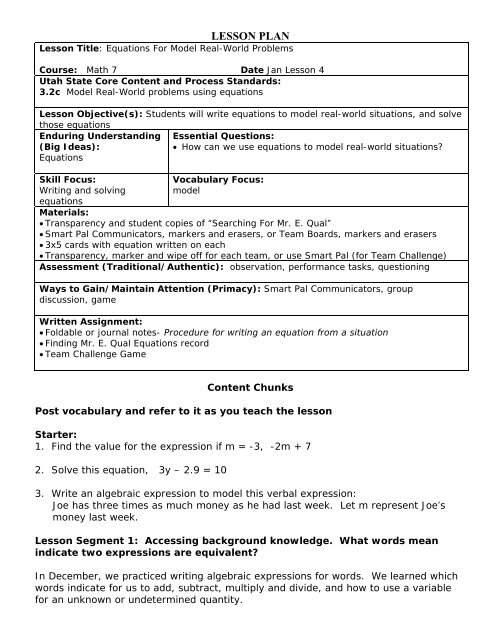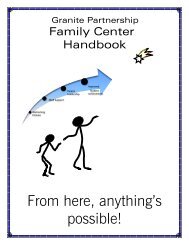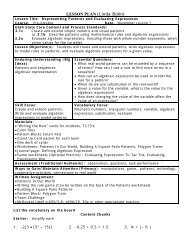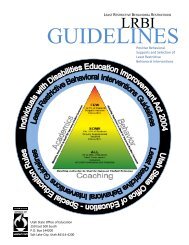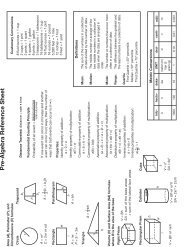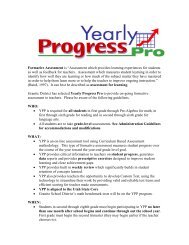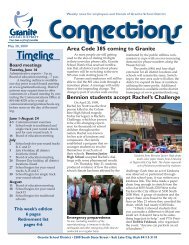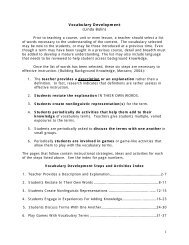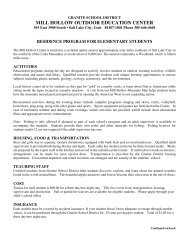LESSON PLAN - Granite School District
LESSON PLAN - Granite School District
LESSON PLAN - Granite School District
You also want an ePaper? Increase the reach of your titles
YUMPU automatically turns print PDFs into web optimized ePapers that Google loves.
<strong>LESSON</strong> <strong>PLAN</strong><br />
Lesson Title: Equations For Model Real-World Problems<br />
Course: Math 7 Date Jan Lesson 4<br />
Utah State Core Content and Process Standards:<br />
3.2c Model Real-World problems using equations<br />
Lesson Objective(s): Students will write equations to model real-world situations, and solve<br />
those equations<br />
Enduring Understanding Essential Questions:<br />
(Big Ideas):<br />
• How can we use equations to model real-world situations?<br />
Equations<br />
Skill Focus:<br />
Writing and solving<br />
equations<br />
Vocabulary Focus:<br />
model<br />
Materials:<br />
• Transparency and student copies of “Searching For Mr. E. Qual”<br />
• Smart Pal Communicators, markers and erasers, or Team Boards, markers and erasers<br />
• 3x5 cards with equation written on each<br />
• Transparency, marker and wipe off for each team, or use Smart Pal (for Team Challenge)<br />
Assessment (Traditional/Authentic): observation, performance tasks, questioning<br />
Ways to Gain/Maintain Attention (Primacy): Smart Pal Communicators, group<br />
discussion, game<br />
Written Assignment:<br />
• Foldable or journal notes- Procedure for writing an equation from a situation<br />
• Finding Mr. E. Qual Equations record<br />
• Team Challenge Game<br />
Content Chunks<br />
Post vocabulary and refer to it as you teach the lesson<br />
Starter:<br />
1. Find the value for the expression if m = -3, -2m + 7<br />
2. Solve this equation, 3y – 2.9 = 10<br />
3. Write an algebraic expression to model this verbal expression:<br />
Joe has three times as much money as he had last week. Let m represent Joe’s<br />
money last week.<br />
Lesson Segment 1: Accessing background knowledge. What words mean<br />
indicate two expressions are equivalent?<br />
In December, we practiced writing algebraic expressions for words. We learned which<br />
words indicate for us to add, subtract, multiply and divide, and how to use a variable<br />
for an unknown or undetermined quantity.
Team Boards or Smart Pal Sleeves<br />
Say any operation (+, -, x, ÷) and ask students to write one word that indicates that<br />
operation. Have them write large enough to show others. Ask students to hold up<br />
their boards or sleeves and allow others to see their word. Repeat for each operation.<br />
Today, we will be extending that to writing equations to represent words or real-world<br />
situations. Since an equation must have two equivalent expressions, it will always<br />
contain and = sign. There are words that indicate there should be an = sign. We find<br />
situations and words that suggest equivalency every day in our world.<br />
Tell students they will be detective partners. Place a transparency of “Searching For<br />
Mr. E. Qual” on the overhead and give students one for their Smart Pal<br />
Communicators. Partners work together to find the word or phrase in each item that<br />
would indicate some expression must be equal to another. Give them a minute to look<br />
at each, then underline and discuss the words on the overhead.<br />
1. is 2. has 3. is the same 4. are equal 5. results in<br />
6. have 7. will be<br />
Lesson Segment 2: How can equations model real-world situations?<br />
Q. How would you go about finding the answer to question 1 (2,3 …) of Finding Mr. E.<br />
Qual? Use Think-Team-Share where students think, then share ideas with their team,<br />
then teacher asks for a team member to tell what the team was thinking. Ask if any<br />
team used a different approach.<br />
“There are probably several ways to approach finding the answer. One way we can<br />
find an answer is to use an equation to model the situation.” Show the students your<br />
equations discussing the 4-step procedure for writing an equation for each situation on<br />
the finding Mr. E. Qual paper as explained below. Students should write and solve each<br />
equation on their own assignment paper<br />
Have students write these on a four flap foldable, or write notes in their journal to refer<br />
to later.<br />
Procedure for writing an equation from a situation<br />
Step 1. First ask, “What does the question want us to find? We can use a variable to<br />
represent what we need to find -the question?<br />
Step 2. Then ask, What operation, + -, x, ÷, do the words in the problem suggest may<br />
be done with the variable? Student may refer to the journal page from Dec,<br />
lesson 2.<br />
Step 3. Then ask, “What are the facts?” (numbers or other symbols that need to be<br />
included in the problem?)<br />
Step 4. Last ask, “What order should all the symbols (numbers, variable, and<br />
operation sign) be placed in?
Possible Equations for Finding Mr. E. Qual<br />
1. What number is described? 5n = 40<br />
2. How much money does Daniel have? D + 4 = 10<br />
3. How long did Marissa work? t = 3<br />
4. How much does each book weigh? 2b = 5<br />
5. What is the number described in # 5? X/8 = 4<br />
6. How many brothers does Emma have? 2e = 8<br />
7. How many years until Sierra is16? 12 + y = 16<br />
Give students an opportunity to practice writing equations and situations using the<br />
“Writing Situations for One-Variable Equations and Equations for Situations Team<br />
Challenge Game (attached)<br />
Assign any additional practice as needed
Searching For Mr. E. Qual<br />
Can you find the words or phrases<br />
in the highlighted sentences that<br />
suggest equivalency?<br />
1. Five times what number is forty?<br />
2. Jose has $10. Jose has four more dollars than Daniel<br />
has. How much money does Daniel have?<br />
3. Maria worked on her project 3 hours. That is the same<br />
number of hours that Marissa worked on her project. How<br />
long did Marissa work?<br />
4. The weights of both textbooks are equal. Together<br />
they weigh 5 pounds. How much does each textbook<br />
weigh?<br />
5. Dividing a number by eight results in four. What is that<br />
number?<br />
6. Monica has three brothers. Karen has five brothers.<br />
Together they have twice as many brothers as Emma.<br />
How many brothers does Emma have?<br />
7. Sierra will be 12 years old this week. She will be 16<br />
years old in how many years?
Writing Situations for One-Variable Equations and Equations for Situations<br />
Team Challenge Game<br />
Objective: Students write situations and equations<br />
Materials needed: equation written on a 3 x 5 card for each team, overhead<br />
transparency and marker for each team<br />
Begin by writing 2x + 3 = 17 on overhead. Tell the students the class will be writing a<br />
story situation to fit this equation. Ask them to choose a topic or object (pizza, CD’s,<br />
dollars, boyfriends, hours watching TV, etc.) Letting the variable represent a number<br />
of those chosen items, discuss words that could be used to indicate the operations.<br />
Point out that the end result is 17. Then, ask the class to help write a story such as:<br />
Marco had several CD’s. His friend, Jaime, owned three more than twice the<br />
number of CD’s Marco had. Jaime owned seventeen CD’s. How many CD’s did<br />
Marco have?<br />
Have the class member solve the equation and answer the question.<br />
Give each team an equation on a 3 x 5 card. Have them work together to write a<br />
situation for their equation and find the solution. When the teams have finished<br />
writing, have their scribe copy their equation and solution on the top of a transparency<br />
page and write the situation on the bottom half. The equations are covered up, so the<br />
class sees only the situation, not the equation. All equations should be recorded on an<br />
assignment paper.<br />
Procedure:<br />
1) When the transparencies are completed, choose a team member to come to the<br />
overhead and put the transparency with the equation covered on the overhead for<br />
the class.<br />
2) The other teams get a few minutes to work to write an equation for it.<br />
3) The person at the overhead chooses any person in the class to come write the<br />
equation on the board, and to explain why he/she thinks that equation works.<br />
4) The person at the overhead then uncovers the original equation and the two<br />
equations are compared for equivalency.<br />
5) If the person being challenged was correct, that person’s team is given<br />
points, treat etc. If not, the challenging team earns points.<br />
This activity gives an excellent opportunity to write and discuss the language of<br />
mathematics, to reason, represent mathematical ideas using correct notation, connect<br />
mathematics to a real-world situation and to problem solve. Allowing teams to work<br />
together, then requiring individual accountability through the selection of “a” person to<br />
respond to the class reduces risk and engages all students. Discussion about<br />
extraneous and important information will be a natural result as well as operations and<br />
order of operations.<br />
Cards: ½ x + 1 = 7 9 = x/3 + 5 x/4 – 3 = 2<br />
6 + 4x = 26 3x + 3 = 18 20 = 2x – 10<br />
x/10 + 5 = 7 3x + 5 = 95 2x + 1 = 13


